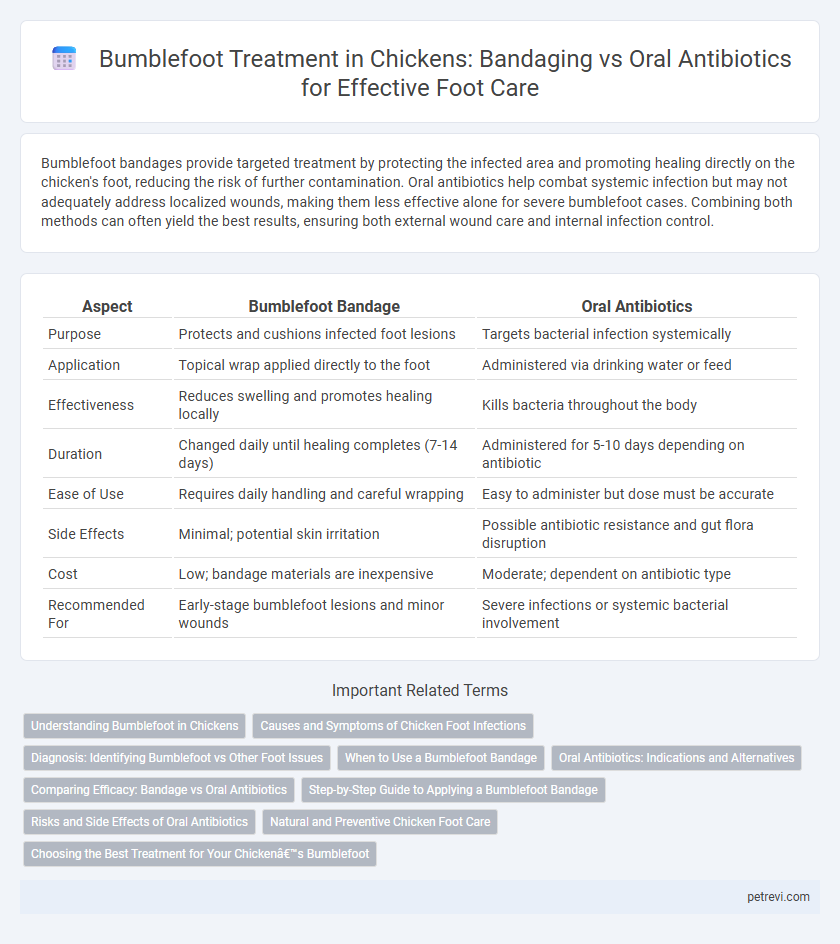Bumblefoot bandages provide targeted treatment by protecting the infected area and promoting healing directly on the chicken's foot, reducing the risk of further contamination. Oral antibiotics help combat systemic infection but may not adequately address localized wounds, making them less effective alone for severe bumblefoot cases. Combining both methods can often yield the best results, ensuring both external wound care and internal infection control.
Table of Comparison
| Aspect | Bumblefoot Bandage | Oral Antibiotics |
|---|---|---|
| Purpose | Protects and cushions infected foot lesions | Targets bacterial infection systemically |
| Application | Topical wrap applied directly to the foot | Administered via drinking water or feed |
| Effectiveness | Reduces swelling and promotes healing locally | Kills bacteria throughout the body |
| Duration | Changed daily until healing completes (7-14 days) | Administered for 5-10 days depending on antibiotic |
| Ease of Use | Requires daily handling and careful wrapping | Easy to administer but dose must be accurate |
| Side Effects | Minimal; potential skin irritation | Possible antibiotic resistance and gut flora disruption |
| Cost | Low; bandage materials are inexpensive | Moderate; dependent on antibiotic type |
| Recommended For | Early-stage bumblefoot lesions and minor wounds | Severe infections or systemic bacterial involvement |
Understanding Bumblefoot in Chickens
Bumblefoot is a common bacterial infection in chickens, characterized by swelling and abscesses on the footpad caused by Staphylococcus bacteria entering through cuts or abrasions. Effective treatment involves thorough cleaning and appropriate bandaging to prevent further infection and promote healing, while oral antibiotics target the underlying bacterial infection systemically. Combining a sterile Bumblefoot bandage with prescribed oral antibiotics typically yields the best recovery outcomes by reducing swelling, eliminating infection, and supporting tissue repair.
Causes and Symptoms of Chicken Foot Infections
Chicken foot infections commonly arise from bacterial entry through cuts, abrasions, or puncture wounds, often caused by rough terrain or poor coop hygiene. Symptoms include swelling, redness, heat, lameness, and the formation of abscesses or scabs on the footpad. Proper identification of these signs is critical for selecting effective treatment methods such as bumblefoot bandages or oral antibiotics to prevent further complications.
Diagnosis: Identifying Bumblefoot vs Other Foot Issues
Accurate diagnosis of bumblefoot in chickens involves observing swelling, redness, and a characteristic black scab on the foot pad, distinguishing it from other foot issues like sprains or cuts. Veterinary examination and sometimes bacterial culture confirm Staphylococcus aureus infection typical of bumblefoot. Identifying these symptoms precisely informs whether to apply a targeted bumblefoot bandage for localized care or administer oral antibiotics for systemic infection.
When to Use a Bumblefoot Bandage
A bumblefoot bandage is essential when treating localized abscesses or cuts on a chicken's foot, as it provides direct protection and prevents further infection. Oral antibiotics are more effective for systemic infections or when inflammation spreads beyond the foot. Proper bandaging supports healing by reducing pressure on the affected area and keeping it clean from dirt and debris.
Oral Antibiotics: Indications and Alternatives
Oral antibiotics are commonly indicated for treating severe Bumblefoot infections in chickens when the condition has progressed beyond mild swelling and localized abscesses. Effective antibiotic choices include enrofloxacin, tylosin, and amoxicillin, which help combat bacterial pathogens such as Staphylococcus aureus and Pseudomonas species. Alternatives to oral antibiotics may involve topical antiseptic treatments, wound cleaning, and bandaging to control infection in early stages or less severe cases.
Comparing Efficacy: Bandage vs Oral Antibiotics
Bumblefoot bandages provide targeted wound protection and promote localized healing by preventing further injury and contamination, making them effective for minor to moderate infections. Oral antibiotics treat systemic bacterial infections, reaching bacteria that local treatments may miss, but carry risks like antibiotic resistance and require precise dosing. Combining both methods often yields the best outcomes, balancing localized care with systemic infection control in chicken foot health management.
Step-by-Step Guide to Applying a Bumblefoot Bandage
Treating bumblefoot in chickens involves a precise step-by-step application of a bumblefoot bandage to promote healing and prevent infection. First, thoroughly clean the affected foot with warm saline solution to remove debris, then carefully trim any scabs or abscesses to expose healthy tissue. Next, apply an antibiotic ointment directly to the wound, cover it with sterile gauze, wrap it snugly with veterinary wrap to secure the bandage, and change the dressing daily while monitoring for signs of improvement or worsening infection.
Risks and Side Effects of Oral Antibiotics
Oral antibiotics for chicken foot care carry risks such as antibiotic resistance, disrupting the bird's gut microbiota, and potential toxicity if dosages are incorrect. Extended use may lead to ineffective treatment and secondary infections due to weakened immune defenses. Bumblefoot bandages minimize systemic side effects by targeting the infection locally and promoting healing without impacting overall health.
Natural and Preventive Chicken Foot Care
Bumblefoot bandages provide targeted, natural treatment by protecting chicken feet from infection while promoting healing through clean, breathable materials. Oral antibiotics disrupt the gut microbiome and may lead to resistance, making preventive foot care with regular cleaning and bandaging a preferable approach. Using herbal poultices and maintaining dry coop conditions further supports natural healing and reduces the occurrence of bumblefoot in chickens.
Choosing the Best Treatment for Your Chicken’s Bumblefoot
Choosing the best treatment for your chicken's bumblefoot depends on the severity of the infection and wound care needs. Bumblefoot bandages provide targeted protection and promote healing by keeping the foot clean and applying medicated dressings directly to the lesion, which can be more effective in mild to moderate cases. Oral antibiotics, prescribed by a veterinarian, are essential for severe infections with systemic involvement, helping to eliminate bacteria internally but should be combined with proper wound care for optimal recovery.
Bumblefoot Bandage vs Oral Antibiotics for Chicken Foot Care Infographic

 petrevi.com
petrevi.com